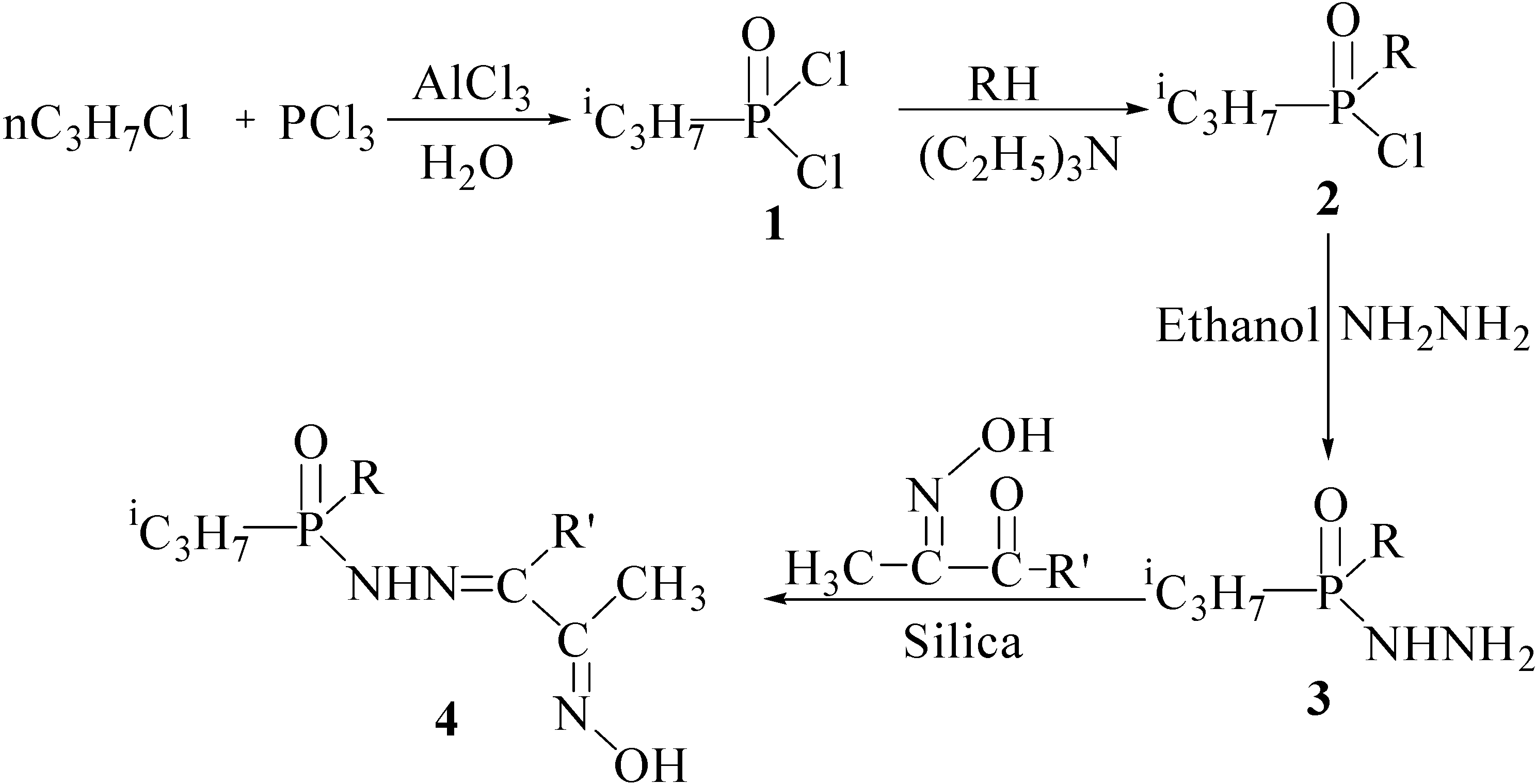A Novel and Efficient Synthesis of N,N-Dialkylaminoisopropyl- and O-alkylisopropyl-2-(1-alkyl-2-oxopropylidene)phosphonohydrazido Oximes - Potential Marine Fish Toxin Analogues. Part 1
Abstract
:Introduction
Result and Discussion

| Entry | R | R1 | Reaction time(h) | 31P-NMRc | m. p. (0C) | Yieldb (%) |
|---|---|---|---|---|---|---|
| 4a | N(C2H5)2 | CH3 | 3.5 | 38.99 | 162 | 75 |
| 4b | N(C3H7)2 | CH3 | 3.8 | 38.16 | 185 | 81 |
| 4c | N(C3H7)2 | C6H5 | 4.0 | 37.97 | 187 | 78 |
| 4d | N(C4H9)2 | CH3 | 3.5 | 39.02 | 142 | 84 |
| 4e | N(C4H9)2 | C6H5 | 4.0 | 38.76 | 193 | 92 |
| 4f | OC3H7 | CH3 | 3.0 | 36.18 | 168 | 87 |
| 4g | OiC3H7 | CH3 | 3.5 | 35.74 | 181 | 83 |
| 4h | OC4H9 | CH3 | 3.0 | 36.08 | 138 | 74 |
| 4i | OiC4H9 | CH3 | 3.5 | 35.69 | 147 | 69 |
Conclusions
Acknowledgments
Experimental
General
General procedure for the preparation ofN,N-diethylaminoisopropyl-2-(1-methyl-2-oxopropylidene)-phosphonohydrazido oxime (4a)
References
- Alam, M.; Oshima, Y.; Shimizu, Y. About Gonyautoxins-1, -11, -111 and-1V. Tetrahedron Lett. 1982, 23, 321–322. [Google Scholar]
- Shimizu, Y. Marine Natural Products; Scheuer, P.J., Ed.; Academic Press: New York, 1978; Vol. 1, Chapter 1. [Google Scholar]
- Lin, Y.Y.; Risk, M.; Ray, S.M.; Von Engen, D.; Clardy, J.; Golik, J.; James, J.C.; Nakanishi, K. Isolation and Structure of Brevetoxin B from the “Red Tide” Dinoflagellate Ptychodiscus brevis (Gymnodinium breve). J. Am. Chem. Soc. 1981, 103, 6773–6775. [Google Scholar]
- James, J.C.; Golik, J.; Nakanishi, K. The Structure of Brevetoxin C. Tetrahedron Lett. 1982, 23, 2535–2538. [Google Scholar] [CrossRef]
- Martin, D.F.; Chatterjee, A.B. Some chemical and physical properties of two toxins from the red tide organism, Gymnodinium breve. U.S. Fish Wild. Serv. Fish. Bull. 1970, 68, 433–443. [Google Scholar]
- Sasner, J.J.; Ikawa, M.; Thurberg, F.; Alam, M. Physiological and chemical studies on Gymnodinium breve davis toxin. Toxicon 1972, 10, 163–172. [Google Scholar] [CrossRef]
- Alam, M.; Sanduja, R.; Hossain, M.B.; Helm, D.V. Gymnodinium breve Toxin. 1. Isolation and X-ray Structure of O,O-Dipropyl(E)-2-(1-methyl-2-oxoprolidene) phosphorohydrazidothiolate-(E)-Oxime from the Red Tide Dinoflagellate Gymnodinium breve. J. Am. Chem. Soc. 1982, 104, 5232–5234. [Google Scholar]
- Dinovi, M.; Trainor, D.A.; Nakanishi, K. The structure of PB-1, an unusual toxin isolated from the red tide Dinoflagellate Ptychodiscus brevis. Tetrahedron Lett. 1983, 24, 855–858. [Google Scholar] [CrossRef]
- Kaushik, M.P.; Parashar, B.D.; Swamy, R.V. Synthesis of Gymnodinium breve Toxin. Ind. J. Chem. 1988, 27B, 1150–1151. [Google Scholar]
- Husain, K.; Kaushik, M.P.; Gupta, A.K. Acute toxicity of synthetic Gymnodinium breve Toxin metabolite and its analogues in mice. Ecotox. Environ. Safety 1996, 35, 77–80. [Google Scholar]
- Koley, J.; Basak, A.K.; Das, M.; Sinha, S.; Dubey, S.N.; Majumder, P.K.; Gupta, A.K.; Das Gupta, S.; Koley, B.N. Effect of synthetic toxin of Ptychodiscus brevis on cardio-vascular and renal function. Ind. J. Physiol. Allied Sci. 1997, 51, 119–125. [Google Scholar] Majumder, P.K.; Gupta, A.K.; Kaushik, M.P.; Deo Kumar; Dubey, S.N. Cardio-vascular effects of organophosphates toxin isolated from Ptychodiscus brevis. Biomed. Environ. Sci. 1997, 10, 85–92. [Google Scholar] Majumder, P.K.; Gupta, A.K.; Deo Kumar; Kaushik, M.P.; Dubey, S.N. Mechanism of cardiotoxicity induced by a marine toxin isolated from Ptychodiscus brevis. Ind. J. Expt. Bio. 1997, 35, 650–654. [Google Scholar] Majumder, P.K.; Gupta, A.K.; Deo Kumar; Dubey, S.N. Calcium mudulatory properties of o,o-diphenyl cyclooctyl phosphoramidates from Ptychodiscus brevis in rat atria and smooth muscle. Ind. J. Physiol. Pharmacol. 1997, 41, 257–262. [Google Scholar]
- Eto, M. Organophosphorus Pesticides: Organic and Biological Chemistry; CRC Press: Boca Raton, FL, 1974; Chapter 5. [Google Scholar]
- Sathe, M.; Gupta, A.K.; Kaushik, M.P. An efficient method for the esterification of phosphonic and phosphoric acids using silica chloride. Tetrahedron Lett. 2006, 47, 3107–3109. [Google Scholar] [CrossRef]
- Kinnear, A.M.; Parren, E.A. Formation of organo-phosphorus compounds by the reaction of alkyl chloride with phosphorus trichloride in the presence of aluminum trichloride. J. Chem. Soc. 1952, 3437–3445. [Google Scholar] [CrossRef]
- Audrieth, L.F.; Gher, R.; Smith, W.C. Nitrogen compounds of the phosphoric and phosphonic acids. 1. Hydrazides of phenylphosphoric and diphenylphosphoric acids. J. Org. Chem. 1955, 20, 1288–1290. [Google Scholar]
- Sample Availability: Contact authors.
© 2007 by MDPI (http://www.mdpi.org). Reproduction is permitted for noncommercial purposes.
Share and Cite
Kumar, R.; Gupta, A.K.; Kaushik, M.P. A Novel and Efficient Synthesis of N,N-Dialkylaminoisopropyl- and O-alkylisopropyl-2-(1-alkyl-2-oxopropylidene)phosphonohydrazido Oximes - Potential Marine Fish Toxin Analogues. Part 1. Molecules 2007, 12, 1334-1340. https://doi.org/10.3390/12071334
Kumar R, Gupta AK, Kaushik MP. A Novel and Efficient Synthesis of N,N-Dialkylaminoisopropyl- and O-alkylisopropyl-2-(1-alkyl-2-oxopropylidene)phosphonohydrazido Oximes - Potential Marine Fish Toxin Analogues. Part 1. Molecules. 2007; 12(7):1334-1340. https://doi.org/10.3390/12071334
Chicago/Turabian StyleKumar, Rajesh, Arvind K Gupta, and Mahabir P Kaushik. 2007. "A Novel and Efficient Synthesis of N,N-Dialkylaminoisopropyl- and O-alkylisopropyl-2-(1-alkyl-2-oxopropylidene)phosphonohydrazido Oximes - Potential Marine Fish Toxin Analogues. Part 1" Molecules 12, no. 7: 1334-1340. https://doi.org/10.3390/12071334
APA StyleKumar, R., Gupta, A. K., & Kaushik, M. P. (2007). A Novel and Efficient Synthesis of N,N-Dialkylaminoisopropyl- and O-alkylisopropyl-2-(1-alkyl-2-oxopropylidene)phosphonohydrazido Oximes - Potential Marine Fish Toxin Analogues. Part 1. Molecules, 12(7), 1334-1340. https://doi.org/10.3390/12071334




